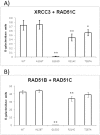RAD51C germline mutations in breast and ovarian cancer cases from high-risk families
- PMID: 21980511
- PMCID: PMC3182241
- DOI: 10.1371/journal.pone.0025632
RAD51C germline mutations in breast and ovarian cancer cases from high-risk families
Abstract
BRCA1 and BRCA2 are the most well-known breast cancer susceptibility genes. Additional genes involved in DNA repair have been identified as predisposing to breast cancer. One such gene, RAD51C, is essential for homologous recombination repair. Several likely pathogenic RAD51C mutations have been identified in BRCA1- and BRCA2-negative breast and ovarian cancer families. We performed complete sequencing of RAD51C in germline DNA of 286 female breast and/or ovarian cancer cases with a family history of breast and ovarian cancers, who had previously tested negative for mutations in BRCA1 and BRCA2. We screened 133 breast cancer cases, 119 ovarian cancer cases, and 34 with both breast and ovarian cancers. Fifteen DNA sequence variants were identified; including four intronic, one 5' UTR, one promoter, three synonymous, and six non-synonymous variants. None were truncating. The in-silico SIFT and Polyphen programs were used to predict possible pathogenicity of the six non-synonomous variants based on sequence conservation. G153D and T287A were predicted to be likely pathogenic. Two additional variants, A126T and R214C alter amino acids in important domains of the protein such that they could be pathogenic. Two-hybrid screening and immunoblot analyses were performed to assess the functionality of these four non-synonomous variants in yeast. The RAD51C-G153D protein displayed no detectable interaction with either XRCC3 or RAD51B, and RAD51C-R214C displayed significantly decreased interaction with both XRCC3 and RAD51B (p<0.001). Immunoblots of RAD51C-Gal4 activation domain fusion peptides showed protein levels of RAD51C-G153D and RAD51C-R214C that were 50% and 60% of the wild-type, respectively. Based on these data, the RAD51C-G153D variant is likely to be pathogenic, while the RAD51C- R214C variant is hypomorphic of uncertain pathogenicity. These results provide further support that RAD51C is a rare breast and ovarian cancer susceptibility gene.
Conflict of interest statement
Figures



References
-
- Jemal A, Siegel R, Xu J, Ward E. Cancer Statistics, 2010. CA Cancer J Clin. 2010;60 - PubMed
-
- Fackenthal JD, Olopade OI. Breast cancer risk associated with BRCA1 and BRCA2 in diverse populations. Nat Rev Cancer. 2007;7:937–948. - PubMed
-
- Sowter HM, Ashworth A. BRCA1 and BRCA2 as ovarian cancer susceptibility genes. Carcinogenesis. 2005;26:1651–1656. - PubMed
-
- Walsh T, King MC. Ten genes for inherited breast cancer. Cancer Cell. 2007;11:103–105. - PubMed
-
- Meindl A, Hellebrand H, Wiek C, Erven V, Wappenschmidt B, et al. Germline mutations in breast and ovarian cancer pedigrees establish RAD51C as a human cancer susceptibility gene. Nat Genet. 2010;42:410–414. - PubMed
Publication types
MeSH terms
Substances
Grants and funding
LinkOut - more resources
Full Text Sources
Medical
Research Materials
Miscellaneous

